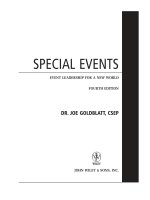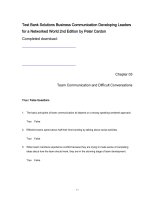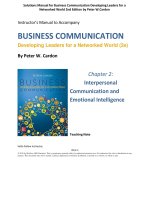Special events event leadership for a new world fourth edition by dr joe goldblatt
Bạn đang xem bản rút gọn của tài liệu. Xem và tải ngay bản đầy đủ của tài liệu tại đây (6.64 MB, 546 trang )
1247.fm 8/16/04 5:00 PM Page iii
SPECIAL EVENTS
EVENT LEADERSHIP FOR A NEW WORLD
FOURTH EDITION
DR. JOE GOLDBLATT, CSEP
JOHN WILEY & SONS, INC.
1247.fm 8/16/04 5:00 PM Page vi
1247.fm 8/16/04 5:00 PM Page i
SPECIAL EVENTS
1247.fm 8/16/04 5:00 PM Page ii
THE WILEY EVENT MANAGEMENT SERIES
SERIES EDITOR: DR. JOE GOLDBLATT, CSEP
Special Events: Event Leadership for a New World, Fourth Edition
by Dr. Joe Goldblatt, CSEP
Dictionary of Event Management, Second Edition
by Dr. Joe Goldblatt, CSEP, and Kathleen S. Nelson, CSEP
Corporate Event Project Management
by William O’Toole and Phyllis Mikolaitis
Event Marketing: How to Successfully Promote Events, Festivals,
Conventions, and Expositions
by Leonard H. Hoyle, CAE, CMP
Event Risk Management and Safety
by Peter E. Tarlow, PhD
Event Sponsorship
by Bruce E. Skinner, CFE, and Vladimir Rukavina, CFE
Professional Event Coordination
By Julia Rutherford Silvers, CSEP
The Complete Guide to Event Entertainment and Production
By Mark Sonder, MM, CSEP
The Guide to Successful Destination Management
By Pat Schaumann, CMP, CSEP
Sports Event Management and Marketing Playbook
By Frank Supovitz
1247.fm 8/16/04 5:00 PM Page iii
SPECIAL EVENTS
EVENT LEADERSHIP FOR A NEW WORLD
FOURTH EDITION
DR. JOE GOLDBLATT, CSEP
JOHN WILEY & SONS, INC.
1247.fm 8/16/04 5:00 PM Page iv
This book is printed on acid-free paper. ᭺
∞
Copyright © 2005 by John Wiley & Sons, Inc. All rights reserved
Published by John Wiley & Sons, Inc., Hoboken, New Jersey
Published simultaneously in Canada
No part of this publication may be reproduced, stored in a retrieval system, or transmitted in
any form or by any means, electronic, mechanical, photocopying, recording, scanning, or otherwise, except as permitted under Section 107 or 108 of the 1976 United States Copyright Act,
without either the prior written permission of the Publisher, or authorization through payment
of the appropriate per-copy fee to the Copyright Clearance Center, Inc., 222 Rosewood Drive,
Danvers, MA 01923, (978) 750-8400, fax (978) 750-4470, or on the web at www.copyright.com.
Requests to the Publisher for permission should be addressed to the Permissions Department,
John Wiley & Sons, Inc., 111 River Street, Hoboken, NJ 07030, (201) 748-6011, fax
(201) 748-6008, e-mail:
Limit of Liability/Disclaimer of Warranty: While the publisher and author have used their best efforts in preparing this book, they make no representations or warranties with respect to the accuracy or completeness of the contents of this book and specifically disclaim any implied warranties
of merchantability or fitness for a particular purpose. No warranty may be created or extended by
sales representatives or written sales materials. The advice and strategies contained herein may not
be suitable for your situation. You should consult with a professional where appropriate. Neither
the publisher nor author shall be liable for any loss of profit or any other commercial damages, including but not limited to special, incidental, consequential, or other damages.
For general information on our other products and services or for technical support, please contact our Customer Care Department within the United States at (800) 762-2974, outside the
United States at (317) 572-3993 or fax (317) 572-4002.
Wiley also publishes its books in a variety of electronic formats. Some content that appears in
print may not be available in electronic books. For more information about Wiley products,
visit our web site at www.wiley.com.
Library of Congress Cataloging-in-Publication Data:
Goldblatt, Joe Jeff, 1952–
Special events : event leadership for a new world / Joe Goldblatt.—4th ed.
p. cm.
Includes bibliographical references.
ISBN 0-471-45037-5
1. Special events—Management.
I. Title.
GT3405.G65 2005
394.2—dc22
2004008519
Printed in the United States of America
10 9 8 7 6 5 4 3 2 1
1247.fm 8/16/04 5:00 PM Page v
DEDICATION
For nearly 25 years, she has walked into her first-grade classroom and gently
helped her little caterpillars become beautiful butterflies. In the chrysalis that
is her classroom, these young minds learn to think and feel. When they confidently fly away to second grade, they take with them sweet memories of her
kindness, integrity, and determination. She is my teacher, friend, and counselor. She has shared the major special events of my life and I have shared in
hers. My life is continually enriched by her presence. This fourth edition of
Special Events: Event Leadership for a New World is dedicated with love and
gratitude to a leader who inspires both young and old, my beloved sister, Leah
Goldblatt Lahasky.
1247.fm 8/16/04 5:00 PM Page vi
“Remember that life is a celebration or can be a celebration. One of the most
important things is to teach man how to celebrate.”
Abraham Joshua Heschel, “Who is Man?”
“Between God and Man,” New York: The Free Press, 1959.
1247.fm 8/16/04 5:00 PM Page vii
CONTENTS
FOREWORD
PREFACE
xi
xv
Part One THEORY OF EVENT
LEADERSHIP 1
Chapter 1
WELCOME TO EVENT LEADERSHIP FOR A NEW WORLD
Chapter 2
MODELS OF GLOBAL EVENT LEADERSHIP
3
37
Part Two EVENT ADMINISTRATION
67
Chapter 3
DEVELOPING AND IMPLEMENTING THE EVENT PLAN
Chapter 4
MANAGEMENT OF HUMAN RESOURCES AND TIME
Chapter 5
FINANCIAL ADMINISTRATION
Chapter 6
EVENT LEADERSHIP
69
117
129
157
Part Three EVENT COORDINATION
Chapter 7
MANAGING VENDOR CONTRACTS
Chapter 8
ON-SITE MANAGEMENT
Chapter 9
ACCOMMODATING SPECIAL NEEDS
169
171
203
259
vii
1247.fm 8/16/04 5:00 PM Page viii
viii
CONTENTS
Part Four
EVENT MARKETING
269
Chapter 10
ADVERTISING, PUBLIC RELATIONS, PROMOTIONS,
AND SPONSORSHIP
271
Chapter 11
ONLINE MARKETING
305
Part Five LEGAL, ETHICAL, AND
RISK MANAGEMENT 313
Chapter 12
RISK MANAGEMENT: LEGAL AND
FINANCIAL SAFEGUARDS
315
Chapter 13
MORALITY, LAW, AND ETHICS IN EVENT MANAGEMENT
341
Part Six TECHNOLOGY AND PROFESSIONAL
DEVELOPMENT 353
Chapter 14
TECHNOLOGY FOR MODERN EVENT MANAGEMENT
Chapter 15
ADVANCING YOUR CAREER IN THE
TWENTY-FIRST CENTURY
367
Chapter 16
CASE STUDIES IN TWENTY-FIRSTCENTURY EVENT LEADERSHIP
397
APPENDIX 1
ORGANIZATIONS AND RESOURCES
APPENDIX 2
INTERNET SITES
APPENDIX 3
REFERENCES
433
APPENDIX 4
PERIODICALS
445
APPENDIX 5
DIRECTORIES
449
APPENDIX 6
AUDIO AND VIDEO RESOURCES
APPENDIX 7
SOFTWARE
APPENDIX 8
SAMPLE CLIENT AGREEMENT
APPENDIX 9
SAMPLE VENDOR AGREEMENT
419
429
453
455
APPENDIX 10 SAMPLE CATERING MENUS
457
461
465
APPENDIX 11 SAMPLE INSURANCE CERTIFICATE
469
355
1247.fm 8/16/04 5:00 PM Page ix
CONTENTS
APPENDIX 12 SAMPLE INCIDENT REPORT
471
APPENDIX 13 SAMPLE PURCHASE ORDER
475
APPENDIX 14 SAMPLE EVENT EVALUATIONS
APPENDIX 15 ISES CODE OF ETHICS
INDEX
485
483
477
ix
1247.fm 8/16/04 5:00 PM Page x
1247.fm 8/16/04 5:00 PM Page xi
FOREWORD
by Sam deBlanc Goldblatt
WHAT IS A PARTY?
There are several ways to answer this question. A young, inexperienced Event
Management student, or likewise a veteran, embittered event planner might
define a party as the right number of tables and chairs, hors d’oeuvres served
at the appropriate time, neat table settings, pleasing decorations, and fun entertainment. This is no doubt a foolproof formula for a satisfying, successful
party. The term party is derived from the Old French term parti, which means
“divided.” The American Heritage Dictionary defines this term as “a social
gathering or a group of people who have gathered to participate in a specific
task or social activity.”
However, an Event Leader—someone who goes above and beyond the status quo practices of the industry—might define a party as a sanctioned period
of escape from the normal rules of society, a time of indulgence, a vacation
from the drudgery of daily life. More than just silverware and tablecloths, a
party represents freedom and release for the invited guests. Parties are about
fun.
I say this knowing full well that the title of this book is Special Events:
Event Leadership for a New World, not Party Planning 101; that much of event
management involves corporate meetings, association meetings, and social
events; and that many professional event managers would resent being called
party planners. Still, my father was planning parties long before he was managing events, and even his major events retained the unmistakable air of a
party.
The Xerox Corporation™ is about the biggest corporate client that an Event
Manager could hope for, and one of the clients my father retained during his
transition from the convention room to the classroom. From such a prestigious
client one might expect elegant black-tie galas with a black-and-white theme
and a string quartet. When I got to peek at the event that my father produced
according to Xerox’s requests, I was shocked to see men and women wearing
shorts and T-shirts and playing indoor sports and games while rock music
played. An Event Manager would know that the evening was an event, but any
xi
1247.fm 8/16/04 5:00 PM Page xii
xii
FOREWORD
of the middle-aged executives acting like rambunctious teenagers would call
it a party.
I am privileged to say that one of my greatest childhood memories is that
of a gigantic genie’s head talking to Donald Trump. For the opening of Trump’s
Taj Mahal Casino in Atlantic City, my father could have produced a typical
opening ceremony with Trump cutting a red ribbon. Instead, he created a
magic lamp the size of a house, which, when Trump rubbed it, brought forth
a genie via a JumboTron™ screen. The genie summoned an awe-inspiring laser
show (a novelty back in the 1980s), which beamed lasers all over the outdoor
audience and culminated in the fall of a giant red ribbon from one of the
casino’s towers followed by a pyrotechnic spectacular. An event, but also a
party.
My final example of the mingling concepts of events and parties goes way
back to 1988, when I was only 3 and my father produced President Ronald
Reagan’s Congressional Picnic at the White House. Obviously, an event of this
magnitude could not escape the traditional strictures of ceremony, etiquette,
formalities, and elegance, right? Well, I’m sure that the utmost level of formality was observed, but all I remember are circus clowns, musicians, mimes
(one of which was my mother), jugglers, and a man with a monkey roaming
around the White House lawn. I still have a photo of President Reagan surrounded by these colorful entertainers and me in a sailor outfit.
In this best-selling textbook, now in its fourth edition, readers will learn
the best practices in modern Event Management. Basic principles, an insider’s
vocabulary, and industry certification standards are but a few of the many
facets of professional guidance offered. The appendices have been reedited in
this edition to provide the most accurate listings of industry organizations,
publications, and businesses. Furthermore, through career advice, real-life examples, and an expert examination of the contemporary business landscape,
the book gives the reader a rare glimpse inside the exhilarating, completely
unmatched industry known as Event Management.
The main difference between this edition and the others, though, is the
emphasis on Event Leadership. Whereas previous editions guided readers toward established careers, this edition guides them toward these careers and
beyond. The first edition of this book, published in 1990, introduced many
people to the new career of Event Management. Today, in 2004, the mainstream visibility of Event Management has grown considerably. As with any
established career, one must surpass expectations in order to succeed—learning not just event management, but also mastering Event Leadership.
An Event Leader must not only be proficient in industry standards and
practices, but also be willing to go beyond the status quo. An Event Leader
must not only respect corporate clients, but also allow them to have fun. An
Event Leader must enliven ordinary ribbon-cutting ceremonies by making
them spectacular. And, like my mother when she performed as a mime at President Reagan’s Congressional White House Picnic, an Event Leader should not
just be in charge of an event—an event leader should be a part of the event.
1247.fm 8/16/04 5:00 PM Page xiii
FOREWORD
My parents’ Event Management organization was called The Wonder Company, probably because most people wondered what on earth it was they did
for a living. Officially, they produced events. In reality, they were planning
parties. Now, in 2004, the strange career of Event Management is widely understood. It is the Event Leader’s job to restore wonder to the profession.
Sam Goldblatt
xiii
1247.fm 8/16/04 5:00 PM Page xiv
1247.fm 8/16/04 5:00 PM Page xv
PREFACE
May you be cursed to live in interesting times.
—ANCIENT CHINESE SAYING
As the third edition of Special Events was being prepared for printing, airplanes were used as weapons of destruction and changed the paradigm of how
we see and act within world events. Suddenly, the world was different, as
travel was dramatically reduced, terrorism alerts became daily expectations,
and our sense of security began to erode. Despite these sudden shocks, the
Event Management industry continues to grow and develop into a more meaningful and, perhaps most importantly, a more sustainable system.
As the World Trade Center towers fell, members of the special events industry in America and throughout the world responded in predictable ways.
According to Ray B. Browne and Arthur B. Neal’s book, Ordinary Reactions
to Extraordinary Events (Bowling Green University Press, 2002), “In many
ways we are our reactions to extraordinary events, which, at least momentarily, alter our world. . . . Through these experiences society develops a little,
perhaps for the better but surely for the different.”
For example, just a few blocks from the site of the World Trade Center
towers, a caterer quickly collected bottles of water and began distributing
them to the victims who were fleeing the scene. Later, the same catering firm
set up a continuous food-service operation to provide complimentary refreshments for the rescue workers.
An Event Management company in Manhattan rented a van and began to
collect essential resources for the rescue workers as well as help organize
many of the logistics necessary to support these workers.
The Event Management industry is perhaps best known for its unlimited
creative resources. A decorator in New York City read in the newspaper that
the search-and-rescue dogs working at Ground Zero were injuring their feet
from stepping upon the sharp glass within the site. These talented event decorators created foot coverings for the dogs to protect them and enable them to
continue their important work.
The professionals within the Event Management industry around the
world responded to the extraordinary events of September 11, 2001, in the
most ordinary of ways. In the first edition of this book, special events were
xv
1247.fm 8/16/04 5:00 PM Page xvi
xvi
PREFACE
described as when the ordinary becomes extraordinary. As Browne and Neal
have discovered through their analysis of numerous major catastrophic events,
human beings generally respond in the most ordinary of ways.
When confronted with a catastrophic event, such as a random act of violence or an emergency weather situation, human beings usually first react in
shock and perhaps even denial. Next, the majority of human beings want to
participate with the event in a positive manner, as best exemplified by members of the special events industry after September 11. Reaction and response,
then, tend to be the universal pattern for human beings when confronted with
catastrophe.
Although September 11 was a major shock, a series of continuing shocks
within North America proceeded to challenge the special events industry.
From contamination of mail by anthrax to the Severe Acute Respiratory
Syndrome (SARS) epidemic to the war in Iraq, the special events industry
has faced each new extraordinary challenge with ordinary reactions and
responses.
As the world has changed, so has the special events industry. That’s why
when Melissa Oliver, Acquisitions Editor at John Wiley & Sons, Inc., asked
me to begin preparing this fourth edition of Special Events—almost immediately following the publication of the third edition—I knew that it was
once again time to refocus this book. I wanted the fourth edition to provide
the essential tools needed in the new world that is quickly developing
around us.
This new world is one in which the terms tourism and terrorism are all
too often used in the same sentence. It is a world in which the global economy continues to languish and where unemployment is rising in many different sectors. It is also a new world in which the special events industry must
once again change in order to sustain itself and grow. This book will provide
you with the tools, information, and systems you will need to fully benefit
from your career in this new world of special events.
In earlier editions of this book, the special events profession was described
as a combination of both art and science. As the profession has matured, the
science, including finance and risk-management procedures, has greatly displaced the earlier focus upon creativity or artistic talent.
This was recently validated when 15 experienced leaders in the Event
Management industry convened in the office of Stedman Graham in Chicago,
Illinois. Graham is a successful sport event manager and marketer and has been
associated with Oprah Winfrey in many humanitarian programs. The purpose
of this meeting was to identify the duties and tasks for Event Leaders.
During this extensive and exhaustive two-day process, the Event Leaders
quickly demonstrated how the profession has evolved and matured. As they
described their duties and tasks, it became evident that the paradigm had
shifted from a field that was once completely opportunistic in nature to one
that is now strategic in design.
1247.fm 8/16/04 5:00 PM Page xvii
PREFACE
FROM EVENT MANAGER TO EVENT LEADER
Throughout this book, you will see numerous new examples of how the profession of Event Management has evolved both naturally and strategically to
focus more and more upon the leadership skills that are needed for long-term
career success.
In the first edition of this textbook, the primary focus was upon developing creative resources and then applying logistics to turn these dreams into
plans that could be executed to achieve successful events.
The Event Leaders agreed that, although creativity is important, it is not
the primary duty or task needed for long-term success in this field. In fact, out
of eight duties and tasks of associated Event Leaders, only one duty, creating
the event, addresses the creative aspect of the profession. While one could argue that creativity is a continuous thread throughout all of the duties associated with the Event Manager, the Event Leaders believe the priority of
responsibilities, and the knowledge associated with those priorities, have indeed expanded, as outlined in Figure P-1 below.
The emerging research within the special events profession continues to
validate and confirm the findings of the Event Leaders. It appears that there
is a newfound body of knowledge linking the modern process of Event Management with the more established field of project management. Project management requires a clear identification of the goals and objectives of the event
and a thorough review and evaluation of each milestone that is established.
Event Leaders are increasingly being held accountable for understanding and
embracing similar competencies. Throughout this book and the others in the
Wiley Event Management series, you will be able to develop and expand your
Event Manager*
Event Leader**
Administration
Coordination
Marketing
Legal, Ethical, Risk
Management
Provide strategic planning
Cultivate business development
Control financial operations
Standardize operations systems
and procedures
Facilitate human resources
Create the event
Orchestrate the event
Pursue professional development
*Body of knowledge for Certified Special Event Professional (CSEP) (1996)
**Duties of Event Leader identified during Developing a Curriculum (DACUM) process
(2002)
Figure P-1.
Comparative Analysis of Event Manager versus Event Leader
xvii
1247.fm 8/16/04 5:00 PM Page xviii
xviii
PREFACE
competency as an Event Leader and, therefore, increase your marketability
and expand your career options.
NEW DATA CREATES THE KNOWLEDGE
YOU NEED TO LEAD
During my eight years at The George Washington University (GW), I conducted empirical Event Management research biannually in cooperation with
the International Special Events Society (ISES). This research was entitled The
Profile of Event Management and, every two years, we surveyed thousands of
event professionals throughout the world to identify changes and trends in
this emerging field of study.
Event Solutions magazine has conducted similar research and a comprehensive report entitled “Event Solutions Fact Book: A Statistical Analysis of
the Event Industry.” Thus far, two studies have been conducted. The most recent
occurred in 2002 and collected data primarily related to 2001. There is a statistically significant correlation between the Event Solutions and the GW/ISES
studies. The following key findings demonstrate the significance of this research:
■
■
■
■
■
■
■
■
■
■
■
■
■
■
The majority of respondents in both studies are event planners.
A large percentage of the respondents are owners of event businesses.
The majority of event businesses are classified as small businesses with
under six employees.
The majority rely upon the Internet and computers to perform their jobs.
The majority are between 31 and 60 years of age. In the Event Solutions
study of 2003, nearly 25 percent are between 51 and 60 years of age.
The majority are female.
A large percentage (20.8 percent) have 20 or more years of experience.
The median number of years of experience is 12.8.
The median lead time before an event is significantly shrinking.
The majority are typically involved in corporate events. However, when
social events and weddings are included in the same data set, the majority are involved in social events.
The majority hold their events at hotels or resorts.
Fewer persons are charging a fee for responding to a request for a proposal (RFP), but 36 percent of all planners charge a fee for a comprehensive design presentation including renderings.
The majority believe the economy is the number one problem facing the
industry.
The majority are members of ISES and Meeting Professionals International (MPI).
In 55.9 percent of the planners’ organizations, there is someone with a
professional certification such as Certified Special Events Professional
(CSEP) or Certified Meeting Professional (CMP). Nine percent of all planners have earned the CSEP designation.
1247.fm 8/16/04 5:00 PM Page xix
PREFACE
■
■
■
■
■
■
■
■
■
■
■
■
■
■
The median gross income was $210,793, but the average gross income
was $1.22 million. This represents a 35.8 percent decrease in the average income that was reported by Event Solutions Fact Book in 2000.
Where 80 percent reported an increase in gross income in 2000, only 42
percent reported an increase in 2001.
The median profit margin as a percentage of gross sales was 15.4 percent.
The median total profit in 2001 was $46,141.
The median invoice amount was $3,702, whereas the average invoice
was $11,126.
The median number of events involved in during 2001 was 60 whereas
the average number of events was 175.
The number of people attending corporate events in 2001 as compared
to 2000 decreased by 25.2 percent.
Although salaries for producers have essentially remained the same, the
increased cost of living makes salaries lower.
Salaries for event designers, planners and coordinators are rising with a
19.6 percent increase for senior designers and directors of events and a
9.5 percent to 9.1 percent increase for event coordinators and directors
of convention services.
Only 19.6 percent experienced no impact from the events of September 11.
The median loss of revenue from the events of September 11 was $33,531
with an average loss of $130,972.
The median number of rescheduled events was 1.3 percent and the average number was 2.4 percent.
The estimated budget reductions for events held within six months of
September 11 was a median of 12.7 percent and an average reduction of
16.8 percent of the total budget.
57.2 percent have had to increase security as a result of September 11
and 31.6 percent elect to employ additional security guards.
The similarity in the findings between the two different data sets is quite remarkable. For example, the GW/ISES study reported in 2000 that the average
number of events produced was 200 and the average budget per event was
$10,000. The Event Solutions Fact Book reported that the average number of
events in 2001 was 175 and the average budget per event was $11,126. In addition to these similarities the salary findings are also comparable and correlate closely with surveys from Meeting Professionals International and other
industry groups.
In almost every category, the data has a significant correlation. However,
the Event Solutions Fact Book data builds upon the earlier research I conducted by including new findings related to the post–September 11, 2001,
economic environment. In the 2000 GW/ISES study, the majority had a high
confidence level in the economy’s future. However, a significant number also
reported that the budget and size of events was decreasing while the number
of events was increasing. The 2000 study may have provided an early warning sign for the usually optimistic special events industry. This ominous
xix
1247.fm 8/16/04 5:00 PM Page xx
xx
PREFACE
foreshadowing may have been the early signal of a weakening global economy
that was further aggravated with the events of September 11, 2001, and
beyond.
Jim Collins in his book Good to Great (HarperCollins, 2002), compares
those companies that have achieved sustainable and progressive growth over
many years with those that have not achieved the same degree of success. One
of the attributes of the successful organizations is that they have within their
ranks a new type of leader who is described by Collins and his fellow researchers as a Level 5 leader. The Level 5 leader offers humility as well as a
strong will for the organization to succeed.
According to Collins, organizations with Level 5 leaders confront the brutal facts and, at the same time, never lose faith. As the special events industry continues to mature and grow, both Level 5 leaders and organizations
willing to confront brutal facts without losing faith are needed to ensure stability and sustainability.
This is exactly why the fourth edition of the venerable industry reference
book Special Events has set forth a series of learning opportunities to prepare
event leaders for a new world. Studies conducted by economists, tourism experts, security analysts, and event-industry researchers such as Event Solutions Fact Book all concur that, for the short- to mid-term, the global economy
will continue to await revival and the confidence of the traveling public (especially with regards to international travel) will remain low.
THE EVENT LEADER
The Johnson & Wales University Event Leader DACUM process not only revealed the principal duties for Event Leaders but also identified the tasks assigned to each duty area. In addition, the experts who participated in this
forum further identified the general knowledge, skills, worker behaviors, future trends and concerns, tools, equipment, supplies, and materials.
Figures P-2 through P-6 summarize these findings.
Duties
Tasks
A. Provide Strategic Planning
A-1 Establish/support organizational mission,
vision, and values; A-2 Develop stakeholder commitment; A-3 Conduct a SWOT (strengths, weaknesses, opportunities, threats) analysis; A-4 Develop
a multi-year plan; A-5 Evaluate strategic plan effectiveness; A-6 Update strategic plan; A-7 Conduct
forecasting activities
Figure P-2. Event Leader Duties and Tasks (listed in order of engagement)
1247.fm 8/16/04 5:00 PM Page xxi
PREFACE
xxi
Duties
Tasks
B. Cultivate Business Development
B-1 Determine market niche; B-2 Determine target
audience(s); B-3 Develop innovative concepts; B-4
Implement a strategic marketing plan; B-5 Implement an advertising and promotions plan; B-6 Implement a sales plan; B-7 Establish strategic alliances and partnerships; B-8 Pursue
industry/market recognition
C-1 Establish accounting practices; C-2 Develop financial relationships; C-3 Establish pricing structure; C-4 Establish compensation structure; C-5 Establish profitability target; C-6 Conduct budgeting
procedures; C-7 Manage cash flow; C-8 Oversee
asset management; C-9 Evaluate profitability
D-1 Establish policies, practices, systems,
and procedures; D-2 Adhere to legal/fiduciary compliance; D-3 Establish equipment requirements; D-4
Establish technology requirements; D-5 Create internal documents; D-6 Coordinate database management; D-7 Review/update policies, practices, systems, and procedures
E-1 Establish ethical expectations; E-2 Establish job
descriptions; E-3 Promote a diverse workforce; E-4
Manage recruiting program; E-5 Conduct orientation
program; E-6 Provide training; E-7 Manage compensation program; E-8 Manage benefits program; E-9
Conduct review process; E-10 Implement feedback
procedures; E-11 Execute recognition program; E-12
Implement retention strategies
F-1 Identify stakeholders; F-2 Establish goals and objectives; F-3 Define quality standards; F-4 Research industry “best practices”; F-5 Design the event; F-6 Establish the budget; F-7 Create the marketing plan; F-8
Create the proposal; F-9 Secure proposal approval
G-1 Implement project-management system; G-2 Coordinate human resources (e.g. volunteers, participants, staff, vendors); G-3 Negotiate vendor contracts;
G-4 Facilitate regulatory compliance; G-5 Execute the
marketing plan; G-6 Coordinate logistics integration
(e.g., venue, vendor/supplier, audience/participant,
media, environment); G-7 Monitor quality standards;
G-8 Manage the budget; G-9 Service the stakeholders; G-10 Monitor risk-management activities (e.g.
safety and security insurance); G-11 Coordinate
follow-up activities; G-12 Analyze outcomes
C. Control Financial Operations
D. Standardize Operations Systems
D. and Procedures
E. Facilitate Human Resources
F. Create the Event
G. Orchestrate the Event(s)
Figure P-2. (Continued)
1247.fm 8/16/04 5:00 PM Page xxii
xxii
PREFACE
Duties
Tasks
H. Pursue Professional Development
H-1 Develop a professional network; H-2 Participate
in industry conferences; H-3 Document career
achievements; H-4 Assess publications; H-5 Evaluate research and trends; H-6 Participate in industry organizations; H-7 Pursue professional credentials; H-8 Pursue academic credentials; H-9 Pursue speaking, writing, and consulting opportunities;
H-10 Engage in mentoring opportunities; H-11 Develop internship, externship, and in-service opportunities; H-12 Maintain life/work balance; H-13
Support community activities; H-14 Conduct benchmarking activities; H-15 Develop alliances with
education providers; H-16 Participate in industry
competitions
Figure P-2. (Continued)
■
■
■
■
■
■
■
■
■
■
■
■
■
■
■
■
■
■
■
■
Communication skills*
■ Oral
■ Listening
Writing
Accounting
Computer
Negotiation
Marketing
Sales
Psychology
Interpersonal*
Organizational*
Stress management*
Cultural sensitivity
Detail oriented*
Leadership*
Androgogy (helping adults learn versus
pedagogy, teaching adults)
Managerial*
Conflict resolution*
Industry knowledge
■ Catering
■ Facilities
Multiple languages**
Adaptability*
■
■
■
■
■
■
■
■
■
■
■
■
■
■
■
■
■
■
■
■
■
■
■
■
■
Artistic
Anthropology
Board leadership
Multitasking*
CPR/First Aid
Heimlich maneuver
Sales
Personality types
Team building*
Coaching
Presentation
Project management
Public speaking
Storytelling
Financial management
Crisis management
“Jack or Jill of all trades”
Entrepreneurial
Analytical
Messianic
Evangelical**
Good judge of quality/character
Change management
Consensus-building skills
Ability to improvise*
Figure P-3. Assorted Event Leader General Knowledge and Skills
1247.fm 8/16/04 5:00 PM Page xxiii
PREFACE
■
■
■
■
■
Union knowledge
Industry customs/standards*
Teaching
Networking
Sociology
■
■
■
■
xxiii
Committee leadership
Knowledge of state and federal laws
Time management*
Visionary
*100 percent of the participants agreed that these are important/essential general knowledge and skill traits
for Event Leaders.
**More than 90 percent of the participants did not agree that these general knowledge and skill traits are
important for Event Leaders.
Figure P-3. (Continued)
■
■
■
■
■
■
■
■
■
■
■
■
■
■
■
■
■
■
■
■
■
■
■
■
■
■
■
Resourceful*
Self-motivated*
Team player
Detail oriented
Creative
Competent*
Cordial
Dedicated
Committed*
Diplomatic
Confident
Kind
Inspirational*
Open-minded*
Ethical
Even-tempered
Mature
Opinionated
Articulate
Consistent*
Well read
Loyal
Lifelong learners
Conversational
Extroverted
Compassionate
Reliable*
■
■
■
■
■
■
■
■
■
■
■
■
■
■
■
■
■
■
■
■
■
■
■
■
■
■
■
Passionate
Honest
Integrity*
Risk taker
Positive*
Tireless
Hard-working*
Decisiveness*
Punctual*
Competitive
Poised
Visionary
Professional
Common sense
Make people feel special*
Provide transformational events
Promote value of education
Sense of humor*
Change agent
Responsible*
“Do whatever it takes” attitude
Global thinker
Educator
Focused*
Disciplined
Empowering
Learn from your mistakes/failures*
*100 percent of the participants agreed that these are critical Event Leader worker behaviors.
Figure P-4. Worker Behaviors for Event Leaders









